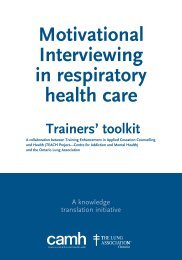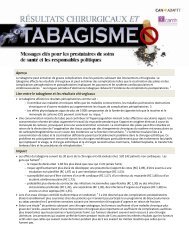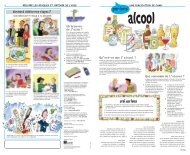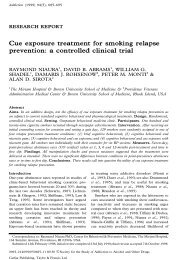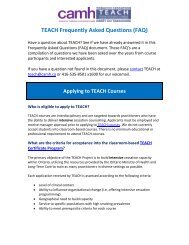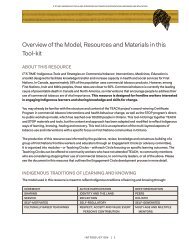SOADI Frontline Training - CAMH - Nicotine Dependence Clinic
SOADI Frontline Training - CAMH - Nicotine Dependence Clinic
SOADI Frontline Training - CAMH - Nicotine Dependence Clinic
Create successful ePaper yourself
Turn your PDF publications into a flip-book with our unique Google optimized e-Paper software.
<strong>SOADI</strong> FRONTLINE TRAINING 11<br />
Food<br />
Healthy eating is a vital part of diabetes management because it<br />
helps people maintain healthy weights and can help delay the onset<br />
of complications. Traditional foods such as wild meat, fish, plants,<br />
and berries are positive additions to the person living with diabetes’<br />
diet.<br />
We are taught that food is medicine. It is therefore important to<br />
nourish our bodies with the proper amounts. This helps us maintain<br />
our spiritual, emotional, physical, and mental health. Healthy eating<br />
includes:<br />
Figure 8 Traditional foods like<br />
berries are a great addition to a<br />
person living with diabetes' diet.<br />
• Three meals per day at around the same time every day.<br />
• Meals served four to six hours apart with healthy snacks<br />
between meals.<br />
• Foods low in fat, salt, and sugar.<br />
• High-fibre foods.<br />
• Using Canada’s Food Guide to help make good food choices.<br />
• Paying attention to portion sizes.<br />
Exercise<br />
Exercise plays an important role in effective diabetes management.<br />
It helps blood flow for a stronger heart, builds strong bones and<br />
muscles, helps us maintain a healthy weight, reduces stress, lowers<br />
blood sugars, and lifts our spirits.<br />
Finding an enjoyable activity is essential, as it should be something<br />
that we do every day. It is also a good idea to exercise after meals.<br />
Monitoring<br />
Good blood-glucose levels decrease the risk of complications. It is<br />
therefore important to:<br />
• Test regularly, at different times of the day.<br />
• Before meals, levels should be 4-7<br />
• 2+ hours after a meal should be 4-7<br />
• 1-2 hours after a meal should be 4-10<br />
• Target ranges may differ for individuals. We are all unique.<br />
• Record levels in a journal to see progress, trends, etc.<br />
• Test if you are not feeling well or if you feel you are having a low<br />
blood sugar reaction.<br />
Taking responsibility and ensuring that we learn how to manage our<br />
blood-glucose levels will help to delay or prevent the onset of<br />
complications.<br />
Figure 9 Keeping track of testing<br />
allows us to view progress.




